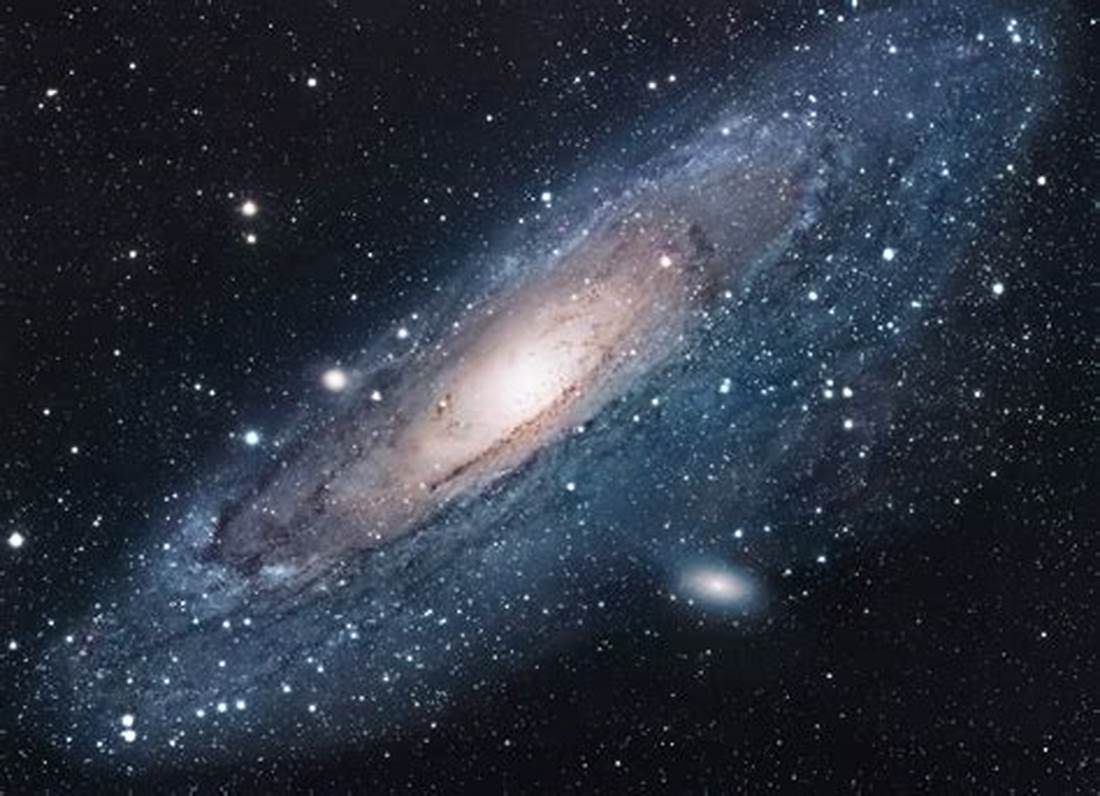The Milky Way is more than two million light-years from the next big galaxy, but that doesn't mean we're alone out here.
银河系距离下一个大星系还有200多万光年的距离,但这并不意味着我们就是孤家寡人了。
There are actually a few dozen smaller satellite galaxies orbiting ours, keeping us company in the neighborhood.
实际上,有很多个小的卫星星系围绕着我们转动,跟我们作伴。

Over the years, they've taught us about star formation and how galaxy clusters behave, so they've been really useful to astronomers.
过去这些年来,这些星系教了我们很多有关恒星组成以及星系团行为方式的知识,所以这些星系对天文学家来说非常有用。
Except, there's a problem: Some satellite galaxies seem to be, well, missing.
除此之外,还有一个问题:一些卫星星系似乎不见了。
In 1998, two independent laboratories noticed that there's a big difference between the number of satellites that simulations predict, and the number we've actually seen with telescopes.
1998年,2个彼此独立的实验室都注意到模拟预测出的卫星数量与望远镜实际观测到的数量有很大不同。
It's called the missing satellite problem, and since we've noticed it, no one's been able to figure out exactly what's going on yet.
这就是所谓的失踪卫星的问题。而虽然我们发现了这个问题,但没有人能够解释其中的原委。
Our galaxy has at least 100 billion stars, but its satellites are much tinier.
银河系至少有1000亿颗恒星,但其卫星的数量就少很多。
Specifically, they're dwarf galaxies, or those that typically have less than a billion stars.
这类星系叫矮星系,也就是恒星数量不足10亿颗的星系。
We've been looking at them for centuries, since several of them, like the Large Magellanic Cloud, can be spotted with the naked eye.
几个世纪以来,我们一直在观测这些星系,因为其中有一部分星系,比如大麦哲伦星云可以用肉眼看到。
But it's only in the last few decades that we've given them serious attention.
但直到最近几十年来,我们才特别关注它们。
Among other things, they're great models for how larger galaxies should behave, which has helped scientists test ideas about everything from stellar activity to chemistry.
这些星系是很好的模型,展示了更大的星系应该怎样运行。它们帮助科学家验证了很多想法,从恒星活动到化学过程,不一而足。
Understanding them could also help us figure out how our own galaxy formed.
了解这些星系还可以帮助我们了解银河系的组成方式。
So astronomers have put a lot of effort into estimating how many should be out there.
所以天文学家花费了很多精力来估测大概有多少个这样的星系。
Many of these studies have involved computer simulations.
这些研究中的很多都用到了计算机模拟。
They're based on the behavior and amount of dark matter in the Milky Way neighborhood, the matter which we can't see but helps hold galaxies together.
这些研究都是基于银河系周遭暗物质的行为和数量来进行的。所谓暗物质,就是我们看不到,但却有助于将各个星系粘合在一起的物质。
They also take into account what we know about the laws of gravity and the universe's expansion.
他们还考虑了引力定律和宇宙扩张中我们了解的部分。
These models suggest that there should be hundreds or even thousands of satellites out there, including plenty massive enough to be visible through telescopes, but we've only seen a few dozen.
这些模型表明,应该有上百颗甚至上千颗卫星,其中包括大的足以用望远镜看到的卫星,但我们目前只能看到几十个。
Since 2005, the Sloan Digital Sky Survey has found almost 20, and since 2013, the Dark Energy Survey has spotted about 20 more.
自2005年以来,史隆数位巡天发现了近20颗卫星。2013年之后,暗能量调查又发现了20颗卫星。
With other findings, that brings the total to about 60.
再加上其他发现成果,就总共有60个了。
And when scientists extrapolate and apply those results to unstudied parts of the sky, they only estimate that there are 100 or so satellites floating around.
当科学家进行推演,并将这些结果用于天空中未研究的部分时,就只能推测出
That's still significantly less than the simulations predict.
这笔模拟预测的要少很多。
And that might mean something is a bit off with our work so far.
这可能意味着:有些东西是我们工作中没有考虑进去的。
It could be that astronomers have been calculating the telescope extrapolations wrong.
可能是天文学家用望远镜推演的不对。
So right now, some researchers are working on recalibrating the statistics from the Sloan Digital Sky Survey.
所以现在,一些研究人员正在研究重新校准史隆数位巡天的数据。
On the other hand, it could be that something is wrong with the models.
另一方面,也可能是模型出了问题。
The good news is, this probably doesn't mean our basic understanding of dark matter is wrong.
好消息是:这很有可能并不意味着我们对暗物质的基本理解是有问题的。
That would be a hard truth to swallow, and would require a lot more evidence.
这个事实可能让人难以接受,需要更多的证据才行。
Instead, it might just mean some small details need to be tweaked, or that other factors are at play.
相反,这也有可能意味着有些小细节需要做调整,或者还有些因素是我们没考虑到的。
For example, a few cosmologists have thrown around the idea that dark matter might operate differently on different scales.
比如,一些宇宙学家到处宣扬他们的想法,即暗物质可能会在不同的维度进行不同的运作。
And research from 2013, published in the Journal of the Italian Astronomical Society, suggests the solution might have to do with the conditions of the early universe.
2013年有一项研究发表在了《意大利天文学会杂志》上。这篇文章指出,解决方案可能跟初期宇宙的环境有关。
Thankfully, whatever the solution is, cosmologists are no strangers to reconciliation.
谢天谢地的是:无论解决方案是什么,宇宙学家都不会轻易妥协。
They come across problems and exceptions in research all the time, so they'll keep working on this case, too.
研究的过程中,会不断遇到问题,也会不断有期待。所以关于这个问题,他们会持续研究下去的。
Basically, that's how science works! And there are already some big projects on the way to help us track down those missing satellites.
这就是科学前进之路本来的样子啊!而且,现在已经有几个大项目在筹备中了。这些项目可以帮助我们追踪到失踪的卫星。
For one, telescopes are getting more powerful all the time, which will help.
一方面,望远镜的功能一直在加强,这会对我们有帮助。
In 2022, the Large Synoptic Survey Telescope, operated by AURA, is scheduled to come online.
2022年,由大学天文研究协会(AURA)运营的大型综合巡天望远镜快要上线了。
It will be able to look at ten square degrees of the sky at once; an area almost 50 times the size of the Moon.
该望远镜将可以一次性观测天空中10平方度的地方,是月球大小的近50倍了。
That means it will be able to look at more of the Milky Way and its surroundings in greater detail than any other telescope to date.
也就是说,该望远镜将可以更细节化地观测银河系及其周边,范围大于目前为止其他所有的望远镜。
It also helps that computers are getting faster, and cosmologists are already using them to enhance their models and simulations.
此外还有所助益的是:计算机的运行速度也越来越快了,宇宙学家也已经开始通过计算机来加强模型和模拟了。
Some simulations, like some being run at Kavli Institute for Particle Astrophysics, pair dark matter simulations with machine learning.
一些模拟,比如Kavli粒子天体物理研究所正在进行的一些模拟,将暗物质模拟与机器学习结合在了一起。
They study hypothetical galaxies to figure out how many dwarf galaxies we'd expect to survive in the real universe.
他们研究了假设的星系,以求弄清楚在真实的宇宙空间里有多少个矮星系。
And other models, like the super high-resolution FIRE simulations, model both dark matter and non-dark matter at the same time to get a more accurate view of how dwarf galaxies form in the first place.
还有一些模型,比如高清FIRE模拟,就将暗物质和非暗物质一起进行了建模,可以更加清楚地看到矮星系是如何形成的。
These studies all hope to emerge with a more accurate picture of our corner of space, which will hopefully help us figure out what's going on with all those missing satellites.
这些研究都希望能够结合宇宙一角里更清楚的图像,这将有希望帮助我们弄清楚失踪的卫星发生了什么事情。
So one day, we'll hopefully know all of our neighbors in space, not just the bright noisy ones.
所以,有朝一日,我们有希望了解宇宙里的所有邻居,而不只是明亮又喧嚣的那些。
And because of that, we'll have a better understanding of how our galaxy got to be the way it is, and how we ended up here.
也因为这一点 ,我们会更好地理解银河系是如何演变到今天的。
Thanks for watching this episode of SciShow Space!
感谢收看本期的《太空科学秀》!
Now, even though we've been studying the universe for centuries, there are still lots of puzzles we haven't solved yet, like one about diffuse interstellar bands.
虽然几个世界以来我们一直在研究宇宙,但还有很多疑惑没有解开,比如弥漫星际带的问题。
These are mysterious light readings scientists have been picking up for nearly a hundred years, and if you'd like to learn more about what they might mean, you can watch our episode all about it.
近100年来,科学家一直在了解一些神秘的读物,而如果大家也想了解神秘读物是什么的话,可以观看一期专门的视频。











